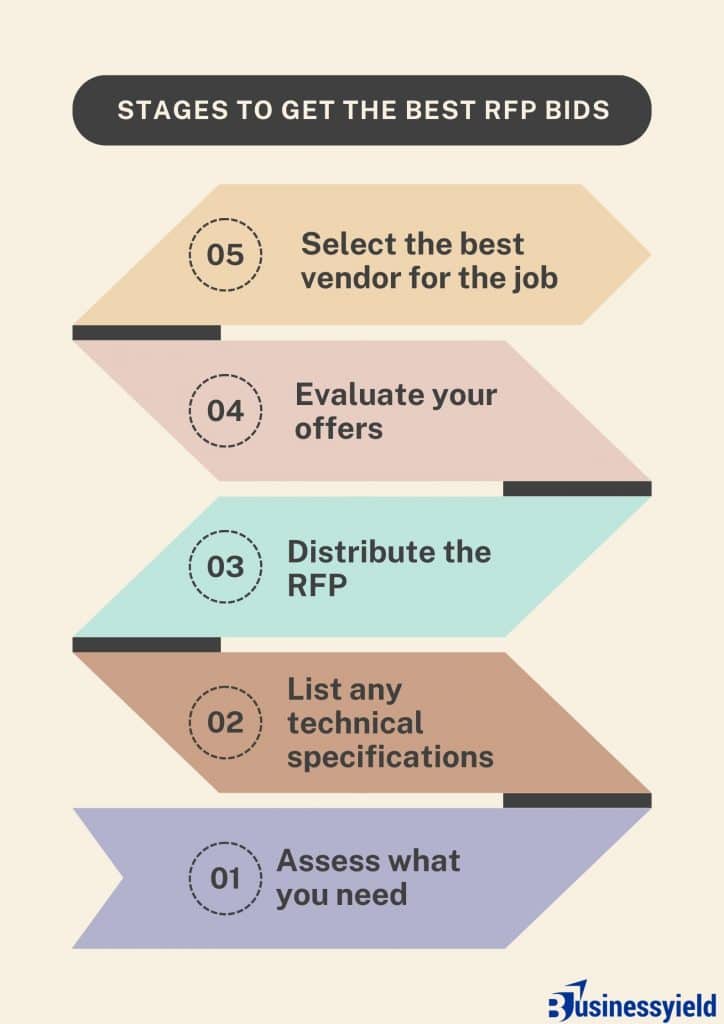How confused were you when you first encountered a task involving drafting an RFP for business? Did you have any idea what it was about or were you totally clueless? Or maybe you hadn’t written one in a while?
Whichever the case may be, I am here to remedy that with this guide. Together, we will dive into the specifics of what an RFP actually is, why you might need one, and how to create your very first one today.
But first, you should probably know what RFP stands for in business.
Key Points
- A request for proposal (RFP) is both the process and documentation used in soliciting bids for potential business or IT solutions required by an enterprise or government agency.
- The RFP document typically outlines a statement of requirements (SOR) to be met by prospective respondents wishing to make a bid to deliver the required solutions.
- It might cover products and/or services to meet the given requirements.
- RFPs are used by most government agencies and many private companies and organizations.
What does an RFP entail in business?
A request for proposal (RFP) is a business document that announces a project, describes it, and solicits bids from qualified contractors to complete it. Most organizations prefer to launch their projects using RFPs, and many governments always use them.
SEE: What Is Product Development? An Expert’s Guide For Product Developers and Managers
When using an RFP, the entity requesting the bids is responsible for evaluating the feasibility of the bids submitted, the financial health of the bidding companies, and each bidder’s ability to undertake the project.
RFPs are used for complex projects, often requiring several sub-contractors. They describe the organization issuing the RFP, the scope of the project being undertaken, and the criteria for evaluating entries. They also outline the bidding process and the contract terms.
The requests include a statement of work describing the tasks to be performed by the winning bidder and the timeline for finishing the work.
RFPs also advise bidders on how to prepare proposals, with specific guidance on how the bids should be formatted and presented. They generally include instructions on what information the bidder must include and the desired format.
What does an RFP include?
An RFP generally includes background on the issuing organization and its lines of business (LOBs), a set of specifications that describe the sought-after solution, and evaluation criteria that disclose how proposals will be graded.
The RFP typically contains a section, sometimes called a statement of work (SOW), defining the scope of work or the scope of service(s) to be provided. This section discusses the tasks to be performed by the winning bidder and a timeline for providing deliverables.
The request for proposal also includes guidance to bidders on how to prepare a proposal. This section will provide the details on the proposal format, as well as instructions on how the RFP response is to be constructed and organized.
READ: How To Write A Business Proposal In Nigeria
Most RFPs are issued by government agencies and other organizations in the public sector. They are generally required to open up competition among private companies and remove bias from the process. The agencies want to ensure that they get the lowest and most competitive bid.
However, any private or public organization may put out an RFP to get multiple bids and a variety of perspectives on the project.
For example, a business that wants to change its reporting process from a paper-based system to a computer-based system may put in an RFP for hardware, software, and a user training program to establish and integrate the new system into the business. A competitive bidding process may give them greater insight into the available alternatives.
When writing an RFP and SOW, it is important to be mindful of organizational processes and best practices, to maximize effectiveness.
Explaining the RFP process
My first encounter with an RFP was when I had to submit a proposal for a business bid; I won’t bore you with the details. But the first thing I learned is that an RFP must be drafted by the company requesting the work. This gives potential contractors a better idea of what your company is looking for.
Once the RFP is sent out, contractors or vendors can review it and submit their best bids to compete for the job.
Here’s what I included in my proposal:
- An action plan of how I would resolve to solve the issue
- A timeline of what the company should expect
- Any necessary background information
- How much I expect the entire project to cost
There were also certain cases where I had to come back and point out specific components of the RFP that needed to be adjusted based on my experience in the industry.
At this point, you can either review their feedback and create a new RFP to adjust for the changes, or you can leave the original as is and keep it in mind while considering the other submitted bids.
SEE: BID PROPOSAL: What It Is & How To Write One
Requirements for drafting an RFP in business
An RFP must describe and define the project in enough detail to attract viable responses.
As a prospective bidder, you should be able to understand the nature of the business and the goals it wishes to achieve with the project. The project must be defined in enough detail for you to clearly understand its scope and all of the products and services that must be provided to carry it out.
The format of the expected proposals must also be detailed. Uniform responses are needed to compare and contrast offers.
Attached below is a checklist detailing the process for creating the perfect RFP:
How to Write an RFP
RFPs follow a fairly rigid format, although that format may vary among the agencies and companies that prepare them. This sample from the RTI International in North Carolina shows the elements in a typical RFP which include an introduction and background, a description of the deliverables, and information about the selection criteria.
Stages to get the best RFP bids

1. Assess what you need
Before you draft an RFP, you’ll need to do a bit of preparation to figure out what you need and what you’d like to accomplish. This process will help you define your goals and project scope, and discover roadblocks.
Use this time to conduct competitor and industry research to evaluate where you stand. Are you following current industry standards and guidelines? Is your product on par with what the competition offers, or are there features you lack that would add value?
READ: Value Proposition Examples That Made A Difference (The Blueprint For Success)
2. List any technical specifications
Including technical specifications up front in your RFP allows vendors to determine whether or not they can provide what you need. This also protects your business because in the event a vendor agrees that they can meet your specifications initially, but fails to deliver once they’ve taken on the project, you can hold them accountable to the specifications listed in the RFP.
3. Distribute the RFP
Once the RFP is written, it’s time to send it out. You can publish it on your website, and maybe even create a specific landing page for it. Leverage any industry-related professional groups you’re a member of and advertise it there. Utilizing your local chamber of commerce is also an excellent place to advertise your RFP if you’d prefer to work with a local vendor.
4. Evaluate your offers
Once you receive all the proposals, it will be almost effortless to compare each one and determine which vendor is the best fit for your company.
Out of the stack of bidders, you’ll want to narrow this down to a handful of your top three, five, or 10 favorites to consider, depending on how many you receive or are interested in. From here, you’ll want to spend time vetting potential vendors further to determine who’s really the ideal fit for the job.
5. Select the best vendor for the job
Some companies may request one more best and final offer from their top vendors after they’ve started this negotiation process. This is to ensure they’re not only getting the right person or company for the job, but at the right price, too.
SEE: BID PROPOSAL: What It Is & How To Write One
While this may sound like an extra step, it may save you money, time, and headaches down the road.
What Not To Do With an RFP in business
If you want to find the right vendor, you need your RFP to be specific. Only asking “yes” or “no” questions won’t get you anywhere. That’s why you must create specific questions that require thoughtful answers. Ask open-ended questions that require them to explain their thought process when solving a problem.
Try to use sentences similar to these:
- Can you share an example of how you’ve solved this problem or a similar one for another company? Did you encounter any unforeseen roadblocks? What would you do the same or differently this time?
- With your proposed redesign, how long would it take a non-tech-savvy person to complete the new registration form? How much time do you estimate this could save?
Sample Response to an RFP
If you’ve issued an RFP and are collecting responses, you might be wondering what you should look for in effective RFP responses. Below is a template sample of an impressive RFP response:
Sample Response to an RFP
But this also leads us to a big question: Is an RFP really necessary in business? Can’t you just spend time reviewing two or three vendors on your own?
As you’ll see next, that route is definitely not in your best interest.
Why you should use an RFP in your business
An RFP may be issued for a number of reasons.
In some cases, the complexity of an IT project calls for a formal RFP. You can benefit from multiple bidders and perspectives when seeking an integrated solution calling for a mix of technologies, vendors and potential configurations. Suppose your business is moving from a paper-based system to a computer-based system, for example. In that case, you might request proposals for all the hardware, software and user training required to establish and integrate the new system into the organization.
READ: ERP vs CRM: Choosing the Right System for Your Business
A simple hardware upgrade, in contrast, may only involve issuing a request for quotation (RFQ) to a single vendor.
Some entities, such as government agencies, may be required to issue RFPs to provide full and open competition.
You may also release an RFP to boost competition to drive down the cost of a solution. That said, a proposal accepted on the basis of being the most responsive to an RFP’s specifications may not always be the lowest-priced bid. As many companies will be competing for business with you, it is important for vendors to craft winning RFP responses.
The skill with which a customer creates an RFP can dictate the quality of a bidder’s response and, therefore, the success or failure of the resulting IT solution. If the specified requirements are too vague, a bidder may miss the mark when it designs and implements the solution. Overly detailed and restrictive requirements, however, limit the bidder’s creativity and stifle innovation.
Companies need to set clear expectations with vendors in order to receive a quality response.
You can use an RFP to:
- Outline project details and expectations: Stakeholders outline the project’s requirements and include details to help potential bidders and contractors understand the scope of the project and the company’s criteria for selecting a vendor.
- Request bids: An RFP kicks off the solicitation or proposal process. By releasing an RFP, companies solicit submissions from contractors. RFP documents are prevalent in the public sector, with many government agencies using the RFP selection process as their primary way of finding qualified service providers.
- Assess multiple vendors: Once companies and freelancers submit their proposals, the business reviews them and chooses the best vendor for their needs. The company uses an RFP to begin conversations with many different vendors or bidders before selecting a winning bidder, extending a final offer, and signing a contract for their project.
What is an RFP in marketing?
In Marketing, an RFP is often used to outsource any marketing activities that could help your brand increase reach. These activities include anything related to marketing that you can’t do internally.
For instance, if you work at a small startup, you might create an RFP to find a full-service communications and marketing firm to create an integrated marketing plan for your business. If this is the case, you’d outline in your RFP that you’re looking for a firm to help you “increase SEO presence” or “attract social media followers”, etc.
On the flip side, if you work for a marketing agency, you’ll want to keep an eye out for RFPs in your area related to the services you offer. For instance, if you work for a web design company, you’ll want to look for businesses that have created RFPs for web design services.
SEE: The Role of Web Design in the Success of Modern Businesses
What is an RFP in sales?
In sales, an RFP is often created when a business is looking to purchase a product or service to suit its needs. For instance, if an enterprise company is looking for a new CRM software, the business might release an RFP that outlines what it’s looking for, and what it’s hoping to achieve with new CRM software.
For this reason, RFPs can play a critical role in the enterprise sales cycle. Enterprise companies that issue RFPs are often looking for businesses that can provide them with IT support, security, onboarding and training, and other additional services. To close these larger accounts, it’s vital your sales team is prepared with an RFP response process and can efficiently respond to these large companies within the time allotted.
READ: Choosing Upselling & Cross-selling Strategies to Strengthen Your Sales Approach
RFI vs. RFP
An RFI (request for information) is a follow-up expression of interest during the RFP bidding process. The company asks for more details about a contractor’s abilities, deliverables, professional services, functionality, timeline, or other vendor information. It differs from an RFP because it’s addressed to a specific vendor (rather than a general call to interested vendors).
An RFI requests particular details instead of general information.
RFQ vs. RFP
An RFQ (a request for quote or request for quotation) is a follow-up document in the RFP process; the company that issued the RFP expresses interest in the contractor’s proposal and asks for a cost estimate and breakdown of their services. As an RFP response, an RFQ applies to a specific vendor on the shortlist (rather than a general call to interested vendors).
It focuses only on the price rather than other project details.
Free RFP Template: The Only RFP Template You’ll Ever Need
What Is An RFP (Request For Proposal): All You Need To Know
BID PROPOSAL: What It Is & How To Write One






